► BYD’s Seal takes on updated Model 3 and Polestar 2
► Old-fashioned body style is given new lease of life
► Which of these family EVs takes the crown?
Established car makers lost faith in the saloon, but some of the best cars from EV specialists have brought new life to an old style. BYD’s new Seal, Tesla’s venerable (and recently updated) Model 3 and Polestar’s Scandi-cool 2 go head-to-head in our comparison test.
Pre-flight briefing: BYD Seal
Why is it here?
The Seal comes from BYD or Build Your Dreams – a new name in the UK but a long-established industrial giant back home in China. It doesn’t just do cars, it does the batteries too. And the Seal looks competitive, with a mid-£40k price, design by Wolfgang Egger and so much standard equipment you’ll probably never need to tick an options box. Previous drives in the Seal have impressed us, and we’re keen to see if it can challenge the incumbents.

Any clever stuff?
The Seal is built on BYD’s e-Platform 3.0, with what it describes as an ‘eight-in-one’ powertrain that integrates the vehicle control unit, battery management system, power distribution unit, drive motor, motor controller, transmission, DC-DC converter and on-board charger. The win is 89 per cent system efficiency and rapid response.
Which version is this?
The entry-level Design spec, which is positioned below range-topping Excellence AWD trims. That means a single e-motor on the rear axle, good for 308bhp, while Excellence AWD adds another one to the front axle, boosting output to 523bhp. All Seals get an 82.5kWh battery with a range of either 323 (Design) or 354 miles (Excellence).
Read our BYD Seal review
Pre-flight briefing: Tesla Model 3 (Highland)
Why is it here?
Not only the benchmark in the affordable EV segment, the Tesla Model 3 is also a former UK best-seller in some months and it’s now been facelifted to keep that competitive edge after six years and two million units. We love the Model 3’s enthusiastic dynamics, the clean-sheet EV architecture that liberates so much interior space and luggage room, Tesla’s Supercharger network and the surprise-and-delight of its infotainment.

Any clever stuff?
This is a careful evolution, most notably with new lamps front and rear for a more mature look. There’s also thicker glass and more sound deadening for a refinement boost, plus a tweaked interior, most controversially featuring gear selection and wiper speeds via the touchscreen. There are no hardware updates for the battery or e-motor and Tesla has the lowest official range on test, but previous experience says its real-world efficiency will take some beating.
Which version is this?
It’s the entry-level Rear-Wheel Drive, which offers 318 miles of range and sits below the Long Range All Wheel Drive with 390 miles. Expect a Performance model to follow.
Read our Tesla Model 3 Highland review
Pre-flight briefing: Polestar 2
Why is it here?
The 2 was the first EV to take the fight to the Model 3 and – with a few reservations – we’ve always rated it highly. It’s now been refreshed with a very gentle visual nip and tuck, and a more significant mechanical makeover to boost both efficiency and driving dynamics.
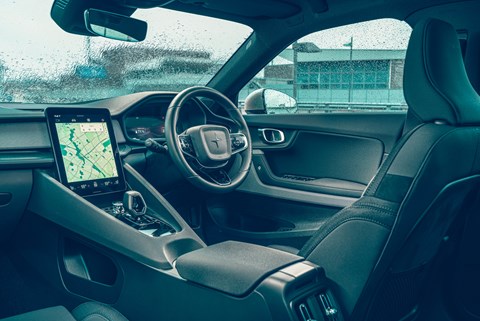
Any clever stuff?
The big news is a switch from front- to rear-wheel drive for the single-motor versions like our test car, and all-wheel-drive range-toppers are tweaked for more rear bias. The e-motors are new too. There’s also a new 82kWh battery and an improved DC charge speed of up to 205kW. Polestar claims the 2 now travels up to 22 per cent further, consumes nine per cent less energy and charges up to 34 per cent quicker.
Which version is this?
It’s the Long Range single-motor version, or the second of four specs. The line-up kicks off with the Standard Range single-motor model, steps up to our test spec then tops out with a Long Range dual-motor version to which you can also add the Performance pack. All bar the entry-level model (69kWh, 339-mile range) get an 82kWh battery pack, which is good for an official maximum of 406 miles on the Long Range single-motor model. There are option packs, not spec levels.
Read our Polestar 2 review
BYD Seal vs Tesla Model 3 vs Polestar 2: the boot’s on the other food

Give years ago this would’ve sounded mad, and even now it seems improbable, but here we are… a triple test in core company-car territory in which all contenders are electric, where Tesla is the best-known brand and from which legacy name plates are purged like CO2 from a greenwashed company report.
Then, in a bizarre retro twist, we note that our test cars aren’t even SUVs, but four-door, rear-wheel-drive saloons. The market’s not so much been disrupted as turned upside down and brusquely shaken by the ankles.
But our rules of engagement are familiar enough. We’re testing EVs costing £40,000-£50,000 and offering around 300-400 miles of range with 250-300bhp. Endless driver-assist features and whizzy touchscreens to dwarf iPads are not mandatory, but guess what?
Tesla has driven this revolution with its Model 3, which climbed to the upper reaches of the UK’s sales charts in peak Covid. It’s been refreshed not just with over-the-air updates but also a physical nip-and-tuck. No changes to battery or motor, mind.
Polestar’s facelifted 2 has more performance and more range to go with its subtly fettled looks… a timely reboot for the first car to go toe-to-toe with the Model 3, then.

And the BYD? It stands for Build Your Dreams, a new-to-the-UK Chinese outfit that was founded in 1995 as a battery maker, started knocking out everything from forklifts to buses and rapidly grew to become the biggest EV maker in the world’s biggest car market.
Now BYD has built more than three million EVs, and continues to manufacture battery packs in-house, not to mention motors, semiconductors and more. Handy given all those supply-chain bottlenecks that have troubled other car makers.
Despite the comedy name, the Seal definitely deserves to be taken seriously. Under the skin you get BYD’s e-Platform 3.0 architecture and an 82.5kWh lithium-iron-phosphate ‘Blade’ battery, effectively a twist on the familiar lithium-ion battery minus sometimes-evil cobalt. An 11kW three-phase onboard charger is standard – but find a 150kW charger, have all your stars align and you can boost the battery from 30 to 80 per cent in 26 minutes.
The powertrain also integrates eight systems including battery management, drive motor and the on-board charger in one compact unit – in a nutshell it’s good for packaging and good for range.
There’s double-wishbone front suspension and a multi-link rear, and the Seal is skilled enough at crashing to earn a five-star NCAP rating. Our entry-level Design spec costs £45,695 and to that not one option has been added to dazzle your testers – the configurator simply asks you to choose exterior and interior colour. And blimey the standard spec of the Seal is extensive: panoramic roof, 19-inch alloys, keyless entry and go, leather electric memory seats, 360º camera… it’s all here.
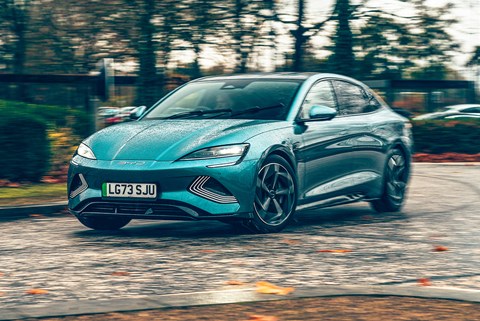
Stepping up to Excellence for just £3k more adds a few more trinkets, a heap of extra performance (523bhp plays 308bhp) and all-wheel drive with a still healthy 323 miles of range, but if it’s a lower price and the max 354 miles of range you want, Design’s the ticket.
And we will be covering miles today, from picturesque Peterborough to company-car heartland Milton Keynes for a nip about town then a blast down some more dynamic roads beyond the 30mph zones. Given today’s low-single-digit temperatures, it’s as close to an EV worst-case scenario as you’re likely to get in the UK. Our efficiency figures will be revealing.
It’s 7am on a dark winter’s morning when I first approach the Seal. The design is surprisingly sophisticated, its gentle curves given definition by crisp lines, sculpted surfacing and a boot that culminates with the satisfying tension of an archer’s bow. The man behind it is Wolfgang Egger, he of gorgeous Alfa 8C fame, not to mention various last-gen Lamborghinis and – most relevant – Audis. Shades of ex-Audi man Peter Schreyer’s transformation of Kia and Hyundai here.
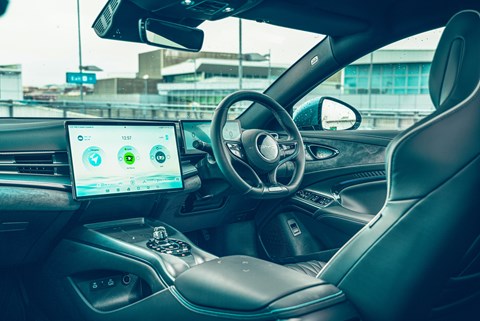
The interior’s equally impressive, with diamond-quilted leather, suedey trim inserts, gloss black surrounds, a stubby little gear selector that could’ve come straight from VW and a whopping great 15.7-inch touchscreen that can rotate from landscape to portrait orientation at the push of a button. It all looks richly specified, warmly welcoming and suitably high-tech.
A large centre console showcases some cheap plastics and shrinks the perceived roominess you’ll find in many EVs up front, but the rear is a properly loungey space thanks to a flat floor and lots of kneeroom for tall adults. It’s just a shame the under-floor battery pack makes you sit so high, whichever pew you choose.
A quick voice command gets the excellent sat-nav up and running and we’re away, the default Sport mode suitably perky, with keen throttle response and progressive, surging acceleration at odds with both the 2055kg kerbweight and modest-sounding 308bhp peak output. Soon we’re in the early-morning rush on the A421, with plenty of owners in their Model 3s and Polestar 2s heading in the same direction, and I knock back to Eco mode mindful of preserving range. It makes a big difference, with Sport’s peppy eagerness giving way to a sticky sort of resistance and pronounced regenerative braking that feels clumsy. Even Normal mode can’t quite lose the lethargy.
Whichever mode you choose, the Seal is refined – the suspension has a long-travel sort of compliance, ruffled only a little by dampers that can get pattery and reactive on tougher surfaces, plus it’s stable at speed and there’s very little wind- or road noise at a 70mph cruise (the front windows are double-glazed). Other than constant bongs for minor speeding infringements and indicators on the wrong side of the wheel like an old Japanese import, I find it very soothing.
On a cross-country sprint the Seal’s steering reveals itself to be punchy and accurate, and here the suspension lets the body move around, yes, but not so much as to become too loose. It even grips hard at the front in these cold, wet conditions and lets me steer it on the throttle just enough to wake up those rear-drive dynamics, even with all stability systems engaged. Add in the surge of electric performance and it’s surprisingly effective and enjoyable point-to-point.
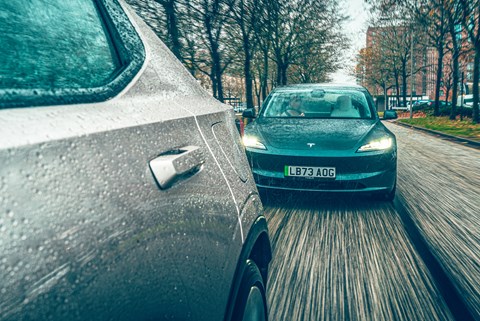
I arrive both a little earlier and more impressed than expected to meet the others, at which point Phil McNamara arrives in the Model 3 and reminds me that the Tesla’s pricing has been aggressively reduced to £39,990 for this entry-level Rear-Wheel Drive model. That’s despite some worthwhile upgrades for the ‘Project Highland’ facelift, including new lamps front and rear (the headlights in particular give the Model 3 a more grown-up look, while helping towards a lower drag coefficient of 0.219), plus thicker glass to boost refinement (never a Model 3 forte), extra sound deadening, new suspension bushes and a fresh steering rack.
The battery and motor might be unchanged, but the range increases a little to 318 miles, and as before you can charge at up to 250kW on Tesla’s excellent Supercharger network. Tesla says you can get up to 175 miles in 15 minutes.
Climb into the Model 3 and it’s the full Mother Hubbard after the generously stocked Seal. It’s been improved over its predecessor, but a whiff of movie set persists here, like it’d all fall over if you blew on it. Thankfully the Tesla’s barrenness extends to spaciousness, because despite being only second longest on test at 4695mm, it feels similarly roomy to the BYD in the rear thanks to a flat floor, loads of legroom and best-on-test headroom. It also offers the biggest boot and frunk here – a huge 561 and 88 litres respectively.
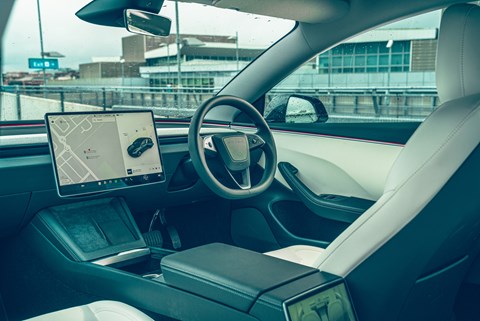
Not everything about this facelift represents progress. Tesla has replaced the control stalks with controls on the steering wheel and touchscreen. This is predictably chaotic, with the indicators frequently moving away from where you thought you’d left them like Laurel and Hardy slapstick. The wipers, meanwhile, give a single sweep with a press at the wheel, but require a prod at the updated 15.4-inch touchscreen to set a speed. Using Autopilot is more intuitive than on the old car, however.
More problematic is the gear selector, which now exists as an avatar on the touchscreen. Slide the virtual car up the screen and the real car is primed to move forward, which may be logical but is opposite to pull-for-forwards/push-for-backwards auto-stick convention.
Thankfully things are much improved on the go. It starts with a mid-engined-like view forwards over the Tesla’s low scuttle, and with a steering wheel that feels not just noticeably smaller than the Seal’s, but more rigidly connected to the front wheels.
Even if there’s next to no road feel, it’s indicative of the Tesla being a much more reactive car generally, switching direction like a sheepdog let loose on the lambs and jinking playfully in time with mid-corner throttle lifts. Plus the body is better controlled than the Seal’s, even as the ride remains sophisticated enough to take the edge off lumps and bumps. It’s a good compromise and feels less brittle than the last 3 I drove.
Peak output might be down around 50bhp on these rivals at 245bhp, but the Tesla is also at least 250kg lighter – an official 1765kg, levelling the playing field. Dig into the throttle and it fires off down the road like Harry Kane’s given it a kick up the backside.

This powertrain is nicely calibrated too, particularly the regenerative braking – good job given you can’t adjust it. You mostly just lift the throttle to slow down, but it’s also deftly enough calibrated to feel pretty natural where other similarly aggressive set-ups can frustrate.
The stability control has a similar finesse. You can’t disengage it and there’s less slack than the Seal’s system, but you can lean into the power to wake the rear-drive chassis up, and the safety systems just gently throttle power back rather than kill it, at least on these mid-speed wet corners. This is the Model 3 we know. But now it has added refinement, with a welcome extra degree of hush.
Where does all this leave the Polestar? Well, it’s still very tempting, not least because of zero per cent APR lease deals like the old days, plus the design is my favourite on test, with a chunky mix of Volvo, crossover and coupe notchback. The exterior’s been lightly fettled for the facelift, including a flush front grille, but it’s increased efficiency that’s the big USP – Polestar says the refreshed 2 can now travel up to 22 per cent further, consume nine per cent less energy and charge up to 34 per cent faster, partly thanks to larger batteries and new motors.
We’re driving the Long Range single-motor model, which upgrades from the entry-level 69kWh battery to 82kWh, adding 67 miles to the range for a best-on-test 406-mile WLTP-certified range. It can charge at up to 205kW, with 10-80 per cent boost in just 28 minutes The Long Range also bumps the price £4k to £48,950 and throws in a performance bonus of 30bhp for 295bhp all in.

Climb inside and the interior can’t match the BYD’s for sophistication, but there’s a Scandi sort of calm and a much more three-dimensional depth to the surfacing compared with the rather mono Tesla. I like the textured fabric trim and ice-like rotary controller, and while the Polestar’s 11.2-inch portrait-orientated touchscreen is the least impressive of the test, it works well enough (though Phil notes the annoying disappearing climate controls at the bottom of the screen).
The Polestar is built on the same CMA platform as the Volvo XC40 crossover (which is available with electric or combustion powertrain), so unlike its tested rivals the 2 doesn’t bring the space-saving benefits of a clean-sheet EV architecture. That’s most notable in the rear seats, where knees are cramped and feet given less room because of the pronounced hump of a transmission tunnel (which actually stows batteries).
To be fair, at 4.6 metres long the Polestar is also shortest on test, yet the boot is still a few litres bigger than the BYD’s at 407 litres and the frunk only a little smaller (41 litres). Just know that teenage kids and adults won’t relish being back here.
I very much like this driving position, though, which feels low like a BMW 3-series after the others and tees up a sporting drive. Thankfully the 2 doesn’t disappoint, in large part because these single-motor versions of the 2 have switched from front- to rear-wheel drive, radically changing the dynamics.
It’s not just silly slidey stuff, but putting driven wheels where weight transfers to under acceleration (good for traction) and separating the steering from the corruptive whump of an e-motor’s instant torque. Driving in convoy cross-country, I initially struggle with some rather alarming mid- to high-speed understeer, but then I discover the knack. There’s more body lean than a Tesla, but give the throttle a lift to get the nose tucked in with some weight transfer and you can drive it out with a progressive squeeze of the power, tweaking it into gentle oversteer as you go.

The Seal lets you do that too, but it’s a less reactive, more stubborn sort of car with a longer wheelbase where the Polestar encourages you to experiment with its balance. Plus the Polestar’s stability control is more laissez faire than the Tesla’s in particular, with a Sport setting that slackens the reins still further.
The ride is also pretty good, with decent compliance on the compression although rebound’s perhaps a little too abrupt. I like the steering’s weight and accuracy too, if not – like all our cars here – its anaesthetised feel. Less impressive is refinement, with too much wind noise in particular at motorway speeds, and 295bhp performance that’s ample but doesn’t have quite the kick of the others.
Three very impressive if imperfect cars, then, and much to think about as we plug in, swap notes and check those efficiency figures.
BYD Seal vs Tesla Model 3 vs Polestar 2: the final reckoning
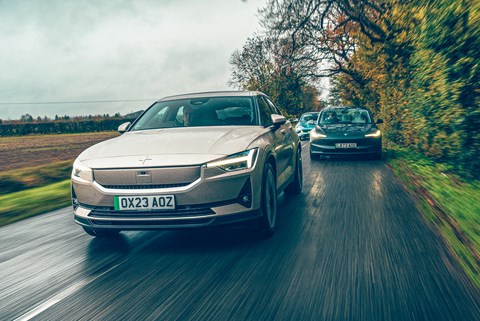
Range is key to EV ownership, so it’s important to reiterate that our test took place on a cold day, heaters and lights ablaze, and involved some spirited driving, so you’re looking at close to worst-case figures here.
But these figures are revealing, because officially the Tesla has the worst range on test at 318 miles. But our test shows it recorded a best-on-test efficiency figure of 2.9 miles per kWh, good for 175 miles of range. The BYD manages an inferior 2.14 miles per kWh, but its battery allows it to go fractionally longer than the Tesla at 177 miles. Polestar has never impressed when it comes to efficiency, so we hoped the refresh would make it more competitive, but sadly it slips from best officially to worst-on-test with 1.77 miles per kWh hour and a range of just 140 miles.
This all helps secure the win for the Tesla, which represents a sensible proposition when bought purely with your head, not least because of its sub-£40k pricing, spacious interior and large luggage compartments. The Model 3 win-win is that it also appeals to the heart with an appealing design, desirable image and a genuinely involving drive. Tesla has maintained the sparky character of the original while layering on more refinement. It is not perfect – we’d like a richer interior, and the ‘simplified’ control interface can be infuriating, but it’s the car I’d buy.
Ranking second and third positions is a tougher task. I prefer the look, image and handling of the Polestar 2 to the Seal, and its interior and driving position are superior to the Model 3’s. Zero per cent finance is another point in its favour. But the refinement, cramped rear packaging and disappointing range rule it out, and given it’s the more direct rival to the Model 3, I’d suggest that’s the car you should buy instead.
Last place for the Polestar, then, but it’s still a car I’d enjoy driving, looking at and sitting in.
So if you want something different to the benchmark Model 3, I’d suggest the BYD Seal. I’d flinch every time I told someone the name, but it offers a more relaxed and refined sort of drive than the Tesla while still flowing nicely point-to-point. It has an impressive design, and a generously equipped and smart-looking interior. It’s also good value, and travelled just a tiny bit further than the Tesla during our test.
A Chinese car, second in a company-car group test. Imagine that five years back.
BYD Seal vs Tesla Model 3 vs Polestar 2: the verdict

First place
Tesla Model 3
Best for value, driving, charging and efficiency, as before. Update adds welcome refinement and some unwelcome control logic
Second place
BYD Seal
Good value; best range (just); sophisticated design; space; more relaxing than the Tesla
Third place
Polestar 2
Enjoyable dynamics and desirable design but cramped rear quarters and worst-on-test range